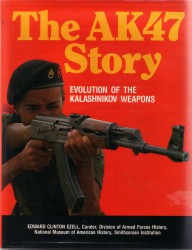 |
Technical Biography:
Mikhail Timofeyevich Kalashnikov, Part 1: The Man |
 |
|
|
|
|
Firearms Technical Trivia, February 2001:
 |
Technical Biography:
Mikhail Timofeyevich Kalashnikov, Part 1: The Man |
 |
This article
is the first half of a two part look at Mikhail Timofeyevich Kalashnikov's
contribution to firearms design. This month we will explore Kalashnikov
the man while next month we will look at the design evolution of the most
prolific military rifle the world has ever known, the AK-47.
Mikhail Timofeyevich Kalashnikov was born on November 10, 1919 to a modest peasant family in Alma-Ata, Kazakhstan. At the age of seven, he entered the Ten Year School (the Soviet equivalent to American primary and secondary education). Upon graduation, Kalashnikov went to work for the Turkestan- Siberian Railroad system, and within two years had risen to the position of technical secretary. Working for the railroad was an important step for Kalashnikov. In the Soviet Union (as in other nations that underwent rapid industrialization) the railroad was a repository of technical knowledge and a hotbed for innovation. As such, it formed a fertile ground for many aspiring engineers like Kalashnikov.
In 1938, Kalashnikov was conscripted for his mandatory service in the Red Army. During his early months in the army, he became more and more interested in small arms. Indeed, Kalashnikov managed to earn the ire of his company commander because of the steady barrage of questions concerning the operating mechanisms of various small arms and other pieces of equipment. The commander, however made a fateful decision that has affected the world to this day. Instead of discouraging Kalashnikov's inquiries, as so many others in the Soviet military might have done, he discerned that real mechanical talent was afoot, and recommended Kalashnikov for a technical course that would qualify him as an armorer once he had completed his basic training. As a result, Kalashnikov attended the training school for tank drivers. While he was there, he designed and built his first piece of new equipment, a mechanism with which to measure the tank's fuel consumption. Later he designed an improved track assembly for tanks.
As a result of these accomplishments, Kalashnikov was promoted to sergeant, and in 1939, was sent to Leningrad to serve as technical advisor for the factory producing his fuel gauge and track assemblies. This posting ended when Nazi forces invaded the Soviet Union on June 22, 1941. Rejoining the active army as a Senior Sergeant, Kalashnikov was posted to a front line armor unit. There he served as a tank commander in Marshal Katukov's First Tank Army. In September 1941, Kalashnikov's unit saw fierce combat during the battle for Bryansk, and his tank was struck by a German shell. Kalashnikov was badly wounded by a shell splinter which ripped open his shoulder. Shuttled from battlefield aid station to a field hospital, he was eventually transferred to a hospital far to the rear.
Lying in the hospital and exchanging war stories with other wounded Soviet soldiers, Kalashnikov heard one refrain repeated over and over again: German superiority in automatic weapons, notably submachineguns, had turned the tactical tide again and again against the Soviet forces. From these conversations, the germ of an idea was planted. Kalashnikov began to think he could contribute more to the war effort as a designer of automatic weapons than as a tanker. He asked the hospital librarian to bring him all the books on small arms available so that he could begin to study existing designs. One of the books was V.G. Fedorov's basic weapons textbook, Evolution of Small Arms, which was published in 1939. As Kalashnikov himself recalls:
That was my lucky day. The book by Vladimir Federov proved to be invaluable. It gave me my first insight into the principles of developing automatic firearms, and put me straight on the positive and negative aspects of each class of firearms.Eventually Kalashnikov's wounds healed to the extent that the hospital could do nothing more for him, but time was needed for him to make a complete recovery. As a result, he was sent home, to Alma-Ata for six months.
| Settling into a small log house, Kalashnikov decided to try his hand at designing a submachinegun. Many Soviet designers had experimented in the 1920's and 1930's with pistol caliber submachineguns. All of them had been simple blow-back designs with unlocked breeches and fixed firing pins. The first of these had been designed by F.V. Tokarev in 1926. The experimental design used the rimmed Model 1895 Nagant revolver cartridge. In the 1930's V.A. Degtyarev, S.A. Korovin, F.V. Tokarev, S.A. Prilutskiy, I.N. Kolesnikov, and other designers continued developing submachineguns, but these were chambered for the the 7.62x25mm cartridge used by the Tokarev TT-30 pistol. The first Soviet submachinegun to emerge from this process was the Pistolet Pulemet Degtyareva, or PPD34. The PPD34, and |
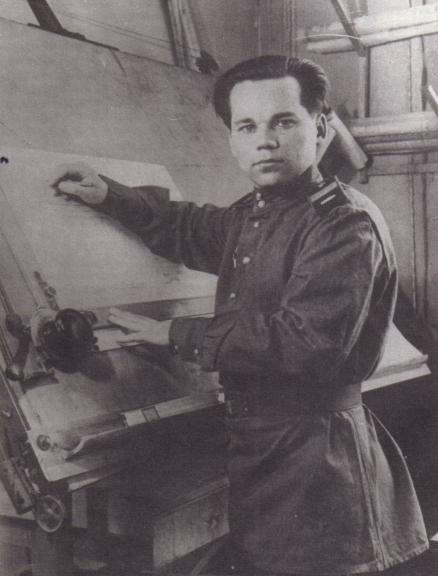
Senior Sergeant Mikhail Timofeyevich Kalashnikov Image Credit: Ezell, Edward Clinton, The AK47 Story, Stackpole Books, Harrisburg, Pennsylvania, 1988, Page 109 |
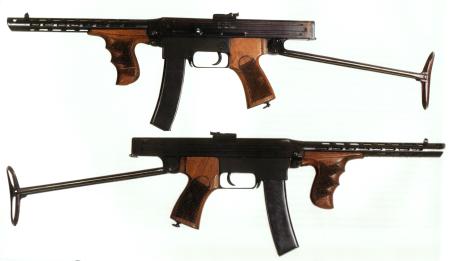
Kalashnikov Submachinegun, 1942 Image Credit: Nedelin, Alexei, Kalashnikov Arms, Design Military Parade, Moscow, 1987, Page 10 |
Kalashnikov's first design is noteworthy only in that it was the beginning of a career in gun design. It fired from a closed bolt when a striker struck the firing pin, and combined this mechanism with an amalgam of features from other designs. While recovering in Alma-Ata, Kalashnikov visited friends in the railway technical section, and convinced one of them, Zhenya Kravchenko to let him use the depot's machine tools to continue his |
The submission of Kalashnikov's gun
was a major breakthrough as it brought Kalashnikov to the attention of
General Anatoly Arkadaevich Blagonravov, the current Chair of Infantry
Weapons at the Dzerzhinskiy Artillery Academy. As a result, the decision
was made to provide Kalashnikov with a formal engineering education.
As a result, Kalashnikov never rejoined the military, but became a technician
at the proving ground at Ensk. While at Ensk Kalashnikov attracted
further attention through his work on modifications to Goryunov machineguns.
These modifications brought him
two "author's certificates," the closest thing the Soviet Union had to
patents. It was also at Ensk that Kalashnikov first came into contact
with such Soviet design luminaries as Degtyarev, Simonov, and Sudayev.
While continuing to work on both 7.62mm and 9x18mm submachineguns, he embarked on a new and more significant course of development when, in 1944 he was given some M1943 7.62x39mm cartridges to examine, and decided to work on a 7.62mm automatic rifle. His first project that used the M1943 cartridge was a selective fire carbine that used a rotating bolt operated by a cam lug moving in a groove in the bolt carrier. While its fixed magazine put it in the same class as the SKS, it used many features which would later reappear in the AK47. The Kalashnikov carbine was tested in 1944 and 1945. Despite a favorable performance, the project was terminated with the adoption of the SKS.
Kalashnikov continued working on
his automatic rifle, but he was not the first to develop an automatic rifle
chambered for the M1943 cartridge. A.I. Sudayev submitted a 7.62x39mm
automatic rifle in early 1944. It was a blowback operated gun using
a massive bolt. Tests indicated that the gun would quickly shoot
itself to pieces, and that further development was needed. Sudayev
then submitted a second design that incorporated a rotating bolt mechanism
and a folding butt. Tests indicated that the gun was too heavy, and
the Artillery Committee of the Main Artillery Commission issued requirements
for decreasing the weight.
| Meanwhile, Kalashnikov's efforts continued. The main design problem, as he saw it, was to design an operating system that could be used in a variety of automatic weapons. After reviewing the options, Kalashnikov settled on the use of a gas operated mechanism. In early 1946, he sent off a technical data package for the new automatic rifle, to the Main Artillery Commission for evaluation. A short time later a reply from Moscow indicated that the design had been selected for development as an |
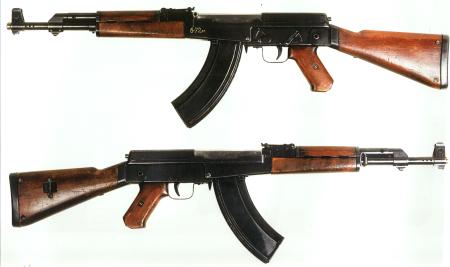
Experimental Avtomat of 1946 Image Credit: Nedelin, Alexei, Kalashnikov Arms, Design Military Parade, Moscow, 1987, Page 30 |
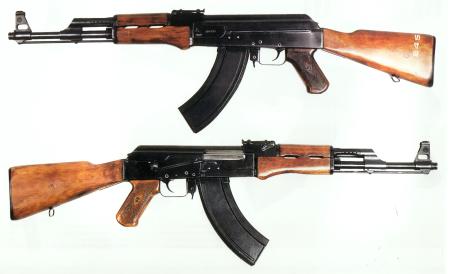
Avtomat Kalashnikova 1947g, First Type Image Credit: Nedelin, Alexei, Kalashnikov Arms, Design Military Parade, Moscow, 1987, Page 50 |
One day in 1949, Engineer-Colonel Demin burst into Kalashnikov's office exclaiming: "Today you must dance, Mikhail Timofeyevich. The Avtomat Kalashnikova has been accepted as a standard weapon." Thus culminated four year of intense design and engineering work with the adoption by the Red Army of the 7.62mm Avtomat Kalashnikova obrazets 1947g (7.62mm Kalashnikov Assault Rifle Model 1947). Large scale production of the AK47 began sometime |
The AK series has been a resounding success, with some 30 million being manufactured to date. As a result of this success, Kalashnikov's career has been very prosperous. A young man in a field dominated by his seniors, Kalashnikov had broken into the elite ranks of the Soviet military technocracy. When released from the Red Army in 1949, Kalashnikov was assigned to the Izhevsk Machine Factory as a civilian engineer. While there, his professional and political star continued to rise. From construction and industrial engineer, he became a senior manager, overseeing production engineering and design operations.
As he rose within the Soviet weapons
design industry, Kalashnikov ceased to be a member of a design team, and
became director of one of the most important weapons design bureaus within
the Soviet Union. After considerable study and evaluation of the
stamped metal assembly process, Kalashnikov and his bureau were able to
perfect a sheet metal receiver for the AK. Subsequent to that, the
Kalashnikov design bureau produced a squad automatic weapon version of
the AKM called the RPK. After
this, the bureau produced a general purpose machine gun, the PK, chambered
for the 7.62x54mmR cartridge. Even the Dragunov 7.62x54mmR SVD sniper
rifle is a product of the Kalashnikov design bureau.
| Kalashnikov
has been honored and feted throughout his career by the Soviet government.
In 1948 he was given the Stalin Prize for Industrial Work. In 1949
he became a Hero of Socialist Labor. He was granted membership in
the Communist Party of the Soviet Union in 1953 and was selected to serve
on the budgetary planning commission for the Soviet Union. In 1966
he was elected to serve as a Deputy of the Supreme Soviet. And in
1971 the title of Doctor of Technical Sciences was conferred upon
him - a Soviet variant on the concept of knighthood.
Kalashnikov's designs are still predominant in the Russian military, although they are slowly being replaced by the Nikonov AN-94. One place where the Kalashnikov designs have not lost any popularity is the American commercial market where semiautomatic versions of his weapons are some of the most popular available to the American shooter. Kalashnikov today stands |
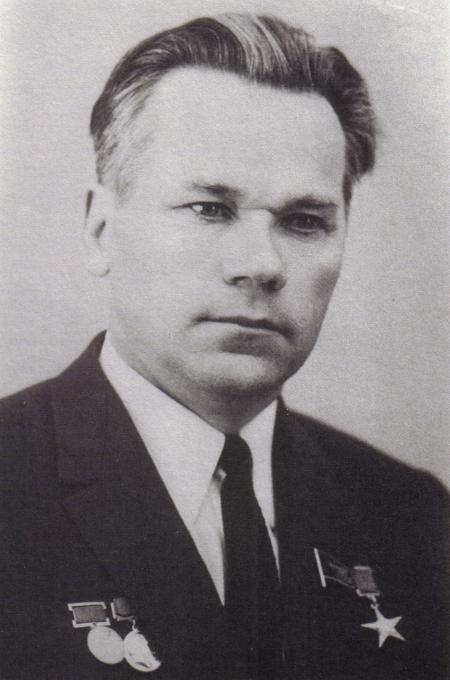
Doctor of Technical Sciences Mikhail Timofeyevich Kalashnikov, Circa 1973 Image Credit: Ezell, Edward Clinton, The AK47 Story, Stackpole Books, Harrisburg, Pennsylvania, 1988, Page 121 |
Note: Data for this month's trivia page was gathered from:
Ezell, Edward Clinton, The AK47 Story, Stackpole Books (Harrisburg, Pennsylvania, 1986) ISBN 0-8117-2247-3
The AK47
Story is available from IDSA Books. Click on the image to order:
